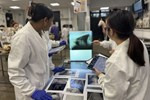Dr Raymond Macharia
Department: Comparative Biomedical Sciences
Campus: Camden
Research Groups: Musculoskeletal Biology, CPCS (Research Programme)
Raymond lectures in Comparative Biomedical Sciences Department.
Raymond G. Macharia is a graduate of Veterinary Medicine from University of Nairobi, He hold an MSc. and PhD in vertebrate muscle growth and development. He also holds a postgraduate certificate in academic practice (PGCAP) and a MSc in Education.
He haspreviously worked at the University of California, Santa Barbara, USA.and the University of Freiburg, Germany.
He lectures and conducts scientific and educational research at the Royal Veterinary College,London; and is Fellow of Higher Education Academy, UK.
He and has contributed to both educational and scientific publications in reputable journals.
Works on various genetic models to determine muscle energetic capacities in relation to growth and ageing. Overall his research is focused on contributing scientific information for the betterment of human health.
1. Propeptide-mediated inhibition of myostatin increases muscle mass through inhibiting proteolytic pathway in mice. Collins-Hooper H, Sartori R, Macharia R, Visanuvimol K, Foster K, Matsakas A, Flasskamp H, Ray S, Dash PR, Sandri M, Patel K. J Gerontol A Biol Sci Med Sci. 2014 Sep;69(9):1049-59.
2.Food Restriction Reverses the Hyper-Muscular Phenotype and Force Generation Capacity Deficit of the Myostatin Null Mouse. Matsakas, V. Romanello, R. Sartori, E. Masiero, R. Macharia, A. Otto, M. Elashry, M. Sandri, K. Patel. Int J Sports Med . 2013 Mar; 34(3):223-31. doi: 10.1055/s-0032-1312605.
3.Exercise training attenuates the hypermuscular phenotype and restores skeletal muscle function in the myostatin null mouse. Matsakas A, Macharia R, Otto A, Elashry MI, Mouisel E, Romanello V, Sartori R, Amthor H, Sandri M, Narkar V, Patel K. Exp Physiol. 2012 Jan;97(1):125-40
4. Neuromuscular junction morphology, fiber-type proportions, and satellite-cell proliferation rates are altered in MyoD(-/-) mice. Macharia R, Otto A, Valasek P, Patel K. Muscle Nerve. 2010 Jul;42(1):38-52.
5. A hypoplastic model of skeletal muscle development displaying reduced foetal myoblast cell numbers, increased oxidative myofibres and improved specific tension capacity. Otto A, Macharia R, Matsakas A, Valasek P, Mankoo BS, Patel K. Dev Biol. 2010 Jul 1;343(1-2):51-62
6. Molecular, cellular and physiological investigation of myostatin propeptide-mediated muscle growth in adult mice. Matsakas A, Foster K, Otto A, Macharia R, Elashry MI, Feist S, Graham I, Foster H, Yaworsky P, Walsh F, Dickson G, Patel K. Neuromuscular Disorders. 2009 Jul; 19(7):489-99.
7. Muscle hypertrophy driven by myostatin blockade does not require stem/precursor-cell activity. Amthor H, Otto A, Vulin A, Rochat A, Dumonceaux J, Garcia L, Mouisel E, Hourdé C, Macharia R, Friedrichs M, Relaix F, Zammit PS, Matsakas A, Patel K, Partridge T. Proc Natl Acad Sci U S A. 2009 May 5;106(18):7479-84.
8. Evidence that a maternal "junk food" diet during pregnancy and lactation can reduce muscle force in offspring. Bayol SA, Macharia R, Farrington SJ, Simbi BH, Stickland NC. Eur J Nutr. 2009 Feb; 48(1):62-5.
9. Lymph heart in chick- Somitic origin, development and embryonic oedema. Valasek P, Macharia R, Neuhuber WL, Wilting J, Becker DL, Patel K. Development. 2007 Dec;134(24):4427-36.
10. Lack of Myostatin in mice results in excessive muscle but impaired force generation, tubular aggregates and alterations in fibre type profile.Amthor H, Macharia R, Navarrete R, Brown SC, Muntoni F, Vrbóva G, and Patel K (2007). PNAS 104: 1835-1840.
11. The morphology of the pectin oculi of the Ostrich, Struthio Camelus S.G. Kiama, J.N. Maina, J. Bhattacharjee, D.K. Mwagi, R.G. Macharia, K.D. Weyrauch . Annals of Anatomy (2006). 188 (6) 519-528.
12. Neuromuscular stimulation causes muscle phenotype-dependent changes in the expression of the IGFs and their binding proteins in developing slow and fast muscle of chick embryos. GM McEntee, BH Simbi, SA Bayol, R.G Macharia and NC Stickland Dev Dyn. (2006). 235 (7) 1777-1784.
13. Myostatin imposes reversible quiescence on embryonic muscle precursors. Amthor H, Otto A, Macharia R, McKinnell I, Patel K. Dev Dyn. (2006) 235(3):672-80.
14. Molecular Mechanisms involving IGF-1 and Myostatin to Induce Muscle Hypertrophy as a therapeutic strategy for Duchenne Muscular Dystrophy. Ketan Patel, Raymond Macharia, Helge Amthor. Acta Myologica (2006)XIV: 230-241.
15. Activin A inhibits formation of skeletal muscle during chick development. He L, Vichev, K, Macharia R, Huang R, Christ B, Patel K, Amthor H. (Anatomy and Embryology (2005) 205: 401- 407.
16. Decamethonium bromide mediated inhibition of embryonic muscle development. Macharia R, Patel K., Otto W., McKinell I., Christ B. Anatomy and Embryology (2004). 208:75- 85 .
17. Comparative morphology of reptilian kidneys. Macheru, P.W., Warui, C.N. and Macharia. R.G. Kenya Veterinarian (2002).Vol 36.
18. Effect of Decamethonium Bromide on the development of larva stages of mosquito Mwangi, D.K., Macharia R.G., Warui C.N. Kenya Veterinarian (2002). Vol. 36.
19. The effect of Decamethonium Bromide induced paralysis on skeletal development in the chick embryo. Macharia R.G., Warui C.N. and Kisia S.M. The Kenya Veterinarian (1998) Vol. 23:61-63.
20. Observations on the morphology of the cloacal region of African Ostrich (struthio camelus massaicus). Warui C.N, Macharia, R.G., Mwangi D.K., Macheru P.W. and Moilo J. The Kenya Veterinarian (1998) Vol.23:53-55.
21. Comparisons between fibre types, fibre-cross section areas and volume densities in the pectoralis muscle of fruit bat and similar sized species of flying birds. Macharia R.G., Warui C.N. and Macheru, P.W. The Kenya Veterinarian (1998) Vol. 23:64-66.
Raymond is involved in several teaching roles at the Royal Veterinary College but primarily teaching on Neurology.
-
Support Hub for Anatomy Research in Education (SHARE)
The SHARE research group is dedicated to the creation, development, and dissemination of novel and effective teaching and learning initiatives in Anatomy Education.

